While plenty of automotive enthusiasts are all about carving corners at the local track days, it’s a special breed that leaves tarmac behind for the dusty trail ahead. If your chosen ride is of the four-wheelin’ variety, here’s how you can modify it to dominate the dirt and mud.
Handling The Terrain
Building a good offroad rig requires a very different focus than building a car for street performance. A screaming high-performance engine is of no use when your tires are spinning in the air because you’re stuck in deep sand or on top of a pointy rock. Instead, four wheelers are concerned with a whole different set of parameters. Ground clearance is key to getting over obstacles without getting stuck, and good articulation is key to keeping your wheels on the ground and pushing you forward in deep ruts and on crazy angles. You’ll also want plenty of low-down torque, and tyres that can grip up in all conditions without snagging a puncture. It’s a whole different ballgame, so read on!
Wheels and Tyres
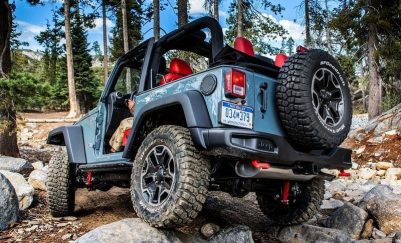
Tyres are the vehicle’s contact with the road, and without a good set of tyres, you’re going absolutely nowhere. Tyre choice for a four-wheel drive application is dependent on where you want to go, and what you want to do. Specialised tyres are available for sand driving, for example, and if you want to play in the mud, a good set of “mud boggers” will do you well. Of course, for those intending to split their time between the highway and the trail, a more conservative set of all-terrain tyres might be the best bet for a blend of off-road performance and on-road comfort.
Fitting bigger tyres is perhaps the most popular modification for offroad vehicles. They’re perhaps the easiest way to gain ground clearance and help a vehicle roll much more easily over small holes and obstacles on trails. However, their greater circumference can decrease vehicle acceleration, and the heavier unsprung weight can lead to handling and braking issues.
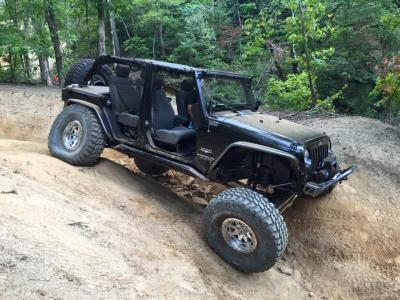
Wheel choice is also a major consideration when outfitting an offroader. Classically, 15″ wheels were the norm, but 17″ designs are now more common. Wheels in this size provide for plenty of sidewall, allowing the tyre to help soak up bumps off road. Choosing an oddball wheel size will give you no end of headaches trying to find tyres to match, so it’s best not to stray from the norm. Of course, if you’re getting super serious, particularly in rock crawling disciplines where very low tyre pressures are key, you might consider getting a set of bead lock wheels. These come with special retaining rings that hold the tyre to the rim mechanically, rather than simply relying on air pressure. These allow the tyres to remain on the rim at incredibly low air pressures, allowing for maximum grip thanks to the greater contact patch of a lower-inflated tyre. However, they add a lot of complexity and weight to a wheel, and can be illegal in some jurisdictions, so be wary.
Lift Kits

Lift kits are another popular way to increase ground clearance of offroad vehicles. They come in two major variations – suspension lifts and body lifts, each with their own strengths and weaknesses. Suspension lifts consist of installing longer springs and higher travel shock absorbers, lifting the entire vehicle’s ride height. This generally offers the best improvement to articulation and ground clearance, however can be expensive due to the need for a full set of new suspension components. A body lift, on the other hand, consists of simply raising the body of the vehicle relative to the chassis. This is cheaper than a suspension lift, and is often done with a series of spacers between the frame and cabin of a vehicle. Commonly done to allow clearance to fit bigger tyres, a body lift does not increase ground clearance of the vehicle in and of itself. Often times, a combination of suspension and body lift will be done, providing more ground clearance and providing the most possible space for larger tyres, further raising the vehicle’s ride height.
Lifts of either kind can have major impacts on handling, due to the higher center of gravity of a lifted vehicle. Additionally, execution can be difficult, with many lifts requiring modifications to drive shaft angles, brake line routing, or even steering shafts. All these components are designed around a set factory ride height, and can only withstand limited adjustment before problems become apparent. Often, lift kits that go beyond a limited height range will come with equipment to help solve these problems during installation.
Locking Diffs
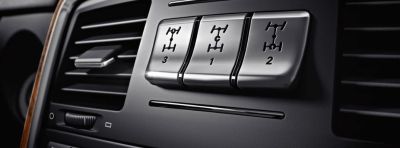
The open differential is a useful invention that allows a car’s wheels to turn at different speeds, such as when cornering. This allows for smooth driving in regular conditions. However, on loose surfaces, it can be more of a hindrance than a help. This is because an open differential transfers torque equally to both wheels. For example, when one wheel is in the air or spinning in mud, it will spin freely. The other wheel attached to the differential will get the same amount of torque as the wheel spinning in the air, which is virtually none. This can make forward progress difficult when one wheel leaves the ground or gets stuck in sand — conditions regularly encountered on any off-road trail.
The popular solution to this is the locking differential, commonly fitted to four-wheel drive vehicles that don’t have time to get stuck. Often available as a factory option, they can also be fitted as an aftermarket upgrade to most popular four-wheel drives and trucks. Available in air and electrically activated versions, when switched on, they lock both sides of the differential together, forcing them to spin at the same speed. This allows greater torque to be supplied to whichever wheel actually has traction, making for much better progress in mud, sand and snow. The trick is that they can be switched on and off, so once back on road, the vehicle can be driven without suffering all the drawbacks of a locked differential on a high-grip surface — like drivetrain damage and annoying tyre squeal around corners.
Locking differentials can be difficult to install for the novice, and may require the assistance of a dedicated diff shop to put together if upgrading a stock differential to locking operation. However, the gains they bring to performance can’t be understated, and they’re a necessity for any serious offroading in mud and sand. Save your pennies, because this hardware certainly doesn’t come cheap!
Accessories
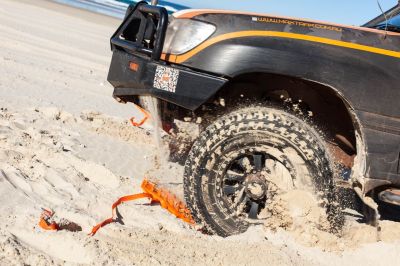
Having the right gear on hand can save you from getting stuck waiting for help on a distant trail. Basic tools are a must, as there’s plenty of hazards offroad that will catch out the unprepared. As a start, a full set of tyre changing gear, including a jack, is key, along with gasoline and water — potable for yourself, and some for the car’s cooling system in the case of overheating. A pair of recovery boards can help if you get bogged, along with a shovel for digging your way out of more serious jams.
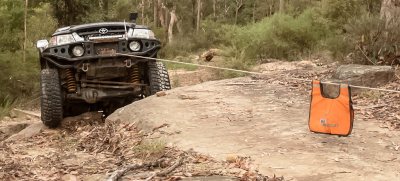
Looking further, you may want to fit brush guards and bash bars to prevent damage to your vehicle from the more gnarly trails out there. These can often serve as great mounting points for additional gear like winches and lights, which can aid in recovery, or help you spot obstacles before you even get stuck in the first place. Having a stout towing point on your vehicle is also key, so you don’t rip a bumper off when a friendly Jeep stops by to pull you out. Of course, when wiring in accessories, make sure to use properly rated conductors and weather proof connectors, otherwise your adventures may be cut short by an electrical fire!
Conclusion
Offroading is a fun practice, and often times, a stock vehicle is more than enough to get started on basic trails. The key is to find out what area of offroading you like, and then modify your vehicle to suit as you gain more driving experience. Spending huge money on a maximum-articulation suspension lift is great for rock crawling, but probably not the first mod you’d make for snow racing, for example. Focus on figuring out what you’re into, and go from there!















This is how to do off road in the US.
https://www.youtube.com/watch?v=KSQd6NrhdyM&t=107s
A few of my friends showed up..
https://www.youtube.com/watch?v=Jt8T868phOA
Finally, an article that covers locking differentials that correctly states an open differential is always a 50-50 torque split, and their real problem is that an open diff can’t split in any other ratio. Zero torque to one wheel means zero torque to the other.
Having not heard of the term “open differential” before, I was thinking it was referring to a differential without a case.
A number of years ago, I mused about a 4WD having a limited slip differential for the front axle.
So if the vehicle got stuck on one side (e.g. right wheels stuck in snow and left wheels on ice) engaging the front axle (switching from 2WD to 4WD) would force movement to at least one wheel on the stuck side.
A conventional limit slip differential will still spin the tire that is in the air (or slightly so) with no power going to the ground. Worm gear limited slips can be made to get the grounded tire to spin with breaking. I had one in my Cherokee, but prefer a selectable front full locking diff now.
We are hackers, my money is on a $500 subaru with welded center and rear diffs, or just stock ;)
https://youtu.be/TmBibFdMIRU
Seriously though an Impreza can be so light in the back a welded diff might be fine on the street, depending how fastly and furiously one drives it might be _less_ wheel slip/scrub (source: drove a plate welded BMW 325i as a daily driver one year, left 2 skinny stripes all over town :D
The older (<2002/2004) automatic uses a electrically operated hydrualic coupling to the rear axles, which you can put on a switch, presto, locking center diff. Under 20mph the stock AWD PWM settings are Very aggressive though, so might not be needed.
In an old issue of Sport Compact Car, I remember reading about a cheap rally Civic hatch that someone had welded the front diff on for off road racing. It reportedly pushed in the turns on the street but was a great cheap option for off-road traction, even on a FWD car.
Body lifts are a joke they don’t even raise ground clearance, suspension lifts are better but still you run into the same problem of the axel. That’s where portal axels come in, basically each wheel has its own gearbox allowing trucks like the G550 4×4 squared an amazing 18” ground clearance. They also take an enormous amount of strain those extremely heavy and large tires and wheels put on your axel and even allow the car to drive as if it had normal size tires. https://www.gwagenparts.com/product/100mm-portal-axle-for-mercedes-g-class-w463-g63-g65-over-500-hp/
That’s the link for an aftermarket G portal axel if you want to take a look at one. If you really want to go nuts you need an independent suspension and portal axels like the atomic axle. That is how you really lift a truck
“Body lifts are a joke they don’t even raise ground clearance,” Uh, you cant put oversize tires on without a body lift.
angle grinder and hammer say otherwise
the Berenstein Bears called and they want their tyres back.
LOL!
It’s actually spelled Berenstain, and misremembering the spelling is a fairly widespread Mandela Effect. Unless you already knew that and were just teasing us?
Bigger tyres & lockers both have the drawback of making it far easier to snap a driveshaft and putting more stress on driveshafts etc.
Then buy stronger driveshafts!
To improve the vehicle, often it’s necessary to be at least as smart as the group of engineers that designed it.
No so common.
Check out YouTube for broken 4×4 trips.
Tell me about it – the nut behind the wheel is the single most important thing to upgrade, good drivers can drive a stock rig in circles round a modded one with an idiot at the wheel.
It iels easier, but its torque transients that break driveshafts, so don’t let the wheels spin and catch.
Either dual low range boxes, or an extra low range box, or gear reduction ‘portal’ hubs can get you into crawl mode.
Lets not forget you can mod your engine to deliver more torque at low RPM, grinding down your CAM, filling in your ports and manifolds to keep velocity up at low engine speed, fitting a 1.5″ or 1.75″ tailpipe, etc. Heavier flywheel. All sorts of thinga one can do. Super charger isn’t out of the question. Nor is hybrid with an electric torque booster.
If you like hacking do yourself a favot and get a 4wd magazine, it is full of real hacks, and not as much fluff and shiny as a street racer/hot rod mag.
Sorry about typos, not sure what the beginning of that was supposed to say.
Back to torque, putting heads or cams from smaller displacement or specific output versions of your engine family on your engine will also move the torque band down and fatten it up on the low end.
Stroking is pretty simple, it makes a longer arm right in the crank, increasing torque right at the source. Check into offset grinding your crank and using a smaller con rod to fit the new crank size.
So many many hacks to be had.
If you want to see a wonder of a factory motor look up the jeep 4.0 inline 6 motor, it has most of its peak torque available at idle, you can literally stick it in gear and hop out, it’ll happily idle away and crawl up the side of your house
Absolutely – but my point was that the article didn’t mention life isn’t as simple as sticking big tyres and lift on and away you go, just like overclocking your PC has drawbacks.
Totally agree that low torque is everything, the number of people who chase HP in an off-road motor and end up with something that’s worse for the job than a stock one is amusing. Many of the mods go against all the “tuner” rules.
Then upgrade the axles. I put a Dana 60 in my Jeep TJ. An endless cycle.
Still enamored with my ’07 Toyota FJ. Does all I need and is capable of more than I’m willing to tackle when it comes to steep, narrow trails (such as Lippincot Rd in Death Valley). I love the dual range 4w transmission, locking differential, etc.
“Choosing an oddball wheel size will give you no end of headaches trying to find tyres to match,”
I found this site useful for choosing t[iy]res for the 16 inch wheels I bought for my vehicle (which came with 15 inch wheels).
https://tiresize.com/tyre-size-calculator/
this is a hobby that is mostly about spending thousands of dollars to show off your truck in parking lots
That’s brotrucks.
Which includes smokestacks, and having headlights right in the height of other vehicles rear view mirror.
nah, it’s nearly the same demographic as vanlife people. they both end up dumb amounts of money on vehicles that pretend they’re “done right” and “functional” but essentially get used 5 times a year, then driven to the coffee shop and work the other 360 days
You only see those trucks because the rest are out on the trail somewhere enjoying themselves – don’t begrudge people their fun.
Finally, someone that understand that not talking about motorsport won’t help climat change. Someone that understand that this was true in the seventies, and it’s still true now! Nothing changed!
Keep in mind that off-road mods affect car’s homologation status (at least in EU). In case of accident your insurance will probably be declared void. It’s no fun to pay repair or even worse – medical costs of people involved.
It’s reckless getting into off-road mods unless you can afford a trailer to haul your toy to track.
And European nations can keep that rule. We will enjoy more freedom here in the USA to modify our vehicles. You would be floored if you only knew how many trucks were modified in the USA. Death on every corner! Call the kangaroo court.
Welcome to the USA. Don’t interfere with my freedom to be stupid or dangerous.
Besides lifted vehicles endangering its occupants (won’t be controllable nor stay upright during any quick maneuvering for collision avoidance) the solid steel bumpers that usually come with winches will maim or kill any innocent bystanders.
People in the UK complain about the rules but they have never looked at the EU where fitting a different size tyre is considered madness. You guys have it bad.
Conversely, I discovered a lot of US states have zero safety inspections, which is terrifying.
I think that comment goes to show you’re not a “car guy”. Modifying any vehicle and keeping it street legal can be interesting, especially when the mods are extreme. Minor changes like tire size, lights, moderate lifts, upgraded brakes and such are mostly pretty easy once you do your homework carefully. The homework involves reading up on the local laws and doing the mods accordingly, most of the time these minor mods do not even have to be inspected.
When you get into more serious things. swapping in a heavier driveline, going from a leaf suspension to coils, solid to independent or, for instance, supercharging the engine, things will get exciting. At that point you most often have to get the vehicle inspected to get the proper stamps on your pink slip. More extreme modifications usually require exemptions from the local government.
The amount of work getting something street legal also varies quite a lot depending on the age of the vehicle as there are things that can be done if the vehicle is built before year X or can be done only if the vehicle is built after year Y. The exact classification and GVW also has a lot to do with what can be done and what is not ok.
As an example. In a given country an M1-class vehicle can take a maximum of 50mm higher tires and it can be lifted a total of 100mm. If the GVW is under 1500kg, no body lift is allowed. Relicense the thing as an M1G and magically you can lift it 150mm. Change the vehicle type to an N1G and you can start installing bull bars on it while keeping the same lifts. If the vehicle is pre-96, you can do pretty much anything with the engine power as long as you do not exceed the emission limits in the yearly inspection. Anything pre 78, and you do not have to worry about the emissions as long as it does not visibly smoke.
It is reckless to hotrod anything unless you know what you are doing. The trailer comes in handy if the mods go too extreme to keep it street legal, usually the truck is extreme enough that you do not even want to run it on any road anymore at that point.
If you’re on a tight budget, with only a welder and an angle grinder, you can check what this guy is doing to a cheap old Audi TT:
https://www.youtube.com/channel/UCRoouSJ-gVz5S29A2HVsCFA/videos
The beauty of this hack is that is the Volkswagen Golf/New Beetle/Jetta platform, second only to the Corolla in mass production numbers. So any of his hacks may be applicable to millions of vehicles.
See new beetle dune buggy concept, and Golf Country, for factory sanctioned offroad models. :)
As an avid offroader since childhood, I started with an VW beetle, Baha Bug, put independent hanbrakes on the rear wheels to be able to brake the spinning wheel and trasfer torqe to the other, via a lifted LandRover on 35″, to a lot of dual duty (on/off road) cars like a Blazer and a Pickup, to now having a dedicated beaten up Wrangler with dual ARB airlockers, onboard air, beadlock rims, 35″ tyres, lower transfercase gearing and a sturdy winch…
You will always get stuck, with more gear you only get stuck further in.
I hand dug the Land Rover out for 2 hours from a mud trail, the next day I kept the speed up and made it further, it took 6h to dig it out. (we had mud up to the side windows)
The land owner came by when we were almost out and said “Yeah, I got my forrest harvester stuck there too, had to call for 2 others to get me out” and ended with, next time you get stuck somewhere around here, just call me and I’ll come and pull you out.
On the topic of body lifts, I say don’t lift bodies – cut fenders!
bigger wheels while showing pics of Jeeps ;—-) = snapped axles / broken shaft. Its not Toyota/Nissan where stock is severely overbuild.
Locking Diffs – modern trucks/suvs are shipping electronic diff like capabilities using ABS sensors and brakes. It often sucks when done badly, but surprisingly works wonders in something like the new Defender (unlike the other shit they crammed into it). It would be trivial to make your own open source ABS add on controller and crowd source best algorithms per terrain type.
Ever since the Freelander 1 did it so effectively I’ve been waiting for someone to create a controller for 4-wheel ABS that does a bit of traction control… still waiting.
The ABS units themselves are cheap enough and robust enough now there should be no great issue, and the potential capabilities (ABS, TC, HDC, fiddle brakes) could be awesome.
I don’t know about the Freelander 1, but I’ve found the FJ’s ATRAC to be very effective on steep, slippery or loose terrain, though one must be in 4-Lo to use it.
Death Wobble….
If you’re going to put a big suspension lift in, you need to be aware of it. Not quite as dangerous as it sounds, but it will definitely make you fill your pants if it unexpectedly happens to you at highway speeds.
Your front tires can suddenly shake fast, like a sloppy shopping cart wheel. Some vehicles are more susceptible than others. It depends on the suspension and steering design, and how worn the linkages are. Plenty of YouTube videos on the subject.
Surprises me there aren’t that many 2ZZ’s or 2ZR’s used in ORV’s like the VW engines. Seems great platform to learn about hacking also given the complexity and ability to make a more open source controls to spoof or tune.
I’ve wondered about coupling with a Subaru or Nissan drivetrain or why not maybe Toyota. I personally want to replace my 360 in the 2001 Dodge Ram with a 2ZR… leaving a transfer case and bringing in an 8 speed. Then again, using the stock prius engine and CVT and adding a gearbox maybe all required. Amazing reliability and potential for hacking into.
I guess like the prius hacked rides… is easy to put a body on a prius and leave as is and tune as required with Techstream or a hacked version of Techstream.
i had a wagonneer 80 customized with 23’wheels and lifted enought to pass over a civic , and almost every weekend i got stucked on mud or a river, probably will need to lift up at least another 15cm, last time crossed a river and water enter by my window and got a messy inside my little baby wagoneer , and yes, i use it daily for going to my work in Caracas and i didnt wash it (formally) since February